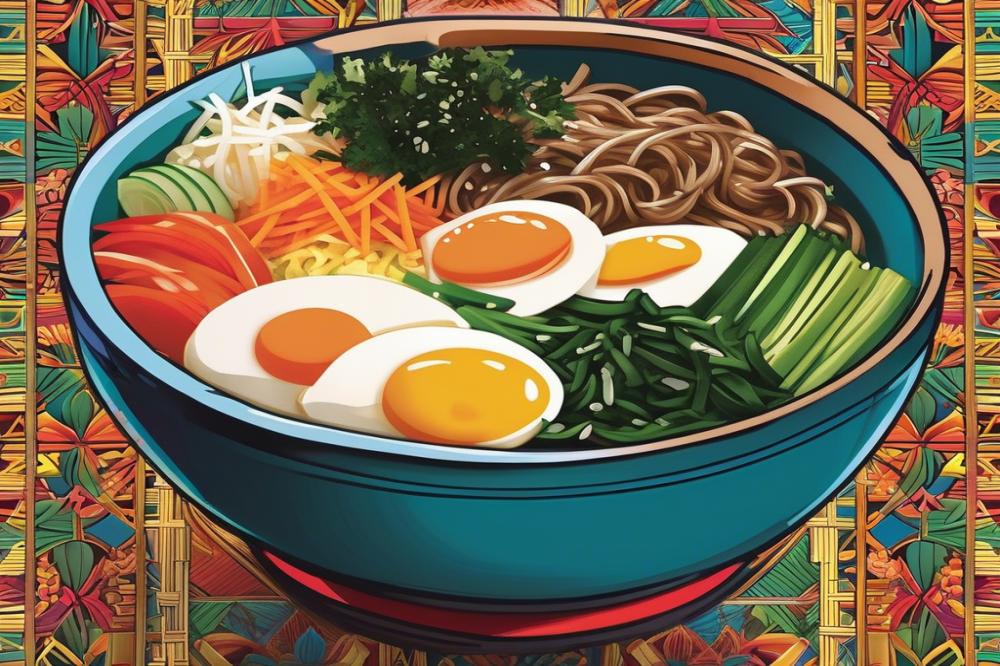Introduction to Bibimbap
Bibimbap is a traditional dish that holds a special place in Korean cuisine. It combines a delightful mix of flavors and textures. This meal is not just delicious; it also fosters a sense of community and togetherness when shared among family or friends. The word itself means “mixed rice,” which perfectly describes how the ingredients come together in harmony.
As a healthy meal option, this dish presents an array of nourishing components. rice serves as the base, providing energy and warmth. Colorful vegetables contribute essential vitamins, transforming it into a vibrant feast for the eyes as well as the palate. Choices can include spinach, carrots, and zucchini, all lightly cooked or stir-fried to maintain their natural crunch. Protein options such as beef or tofu add substance, ensuring that every bite is satisfying. A fried egg on top brings creaminess, adding richness to the overall experience.
Fresh ingredients play a vital role in achieving the perfect Bibimbap. The flavors depend on the quality of vegetables and meat used. Gochujang, a spicy Korean chili paste, is mixed in to deliver depth and a slight kick. A drizzle of sesame oil enhances the aroma and ties together all other elements. Each step in the preparation process is important, as it showcases the art of Korean recipes passed down through generations.
In summary, Bibimbap stands out as a wholesome dish. It celebrates balance in nutrition while offering a burst of flavors that can satisfy any appetite. Trying it makes it clear why it remains a cherished food in Korea.
What is Bibimbap?
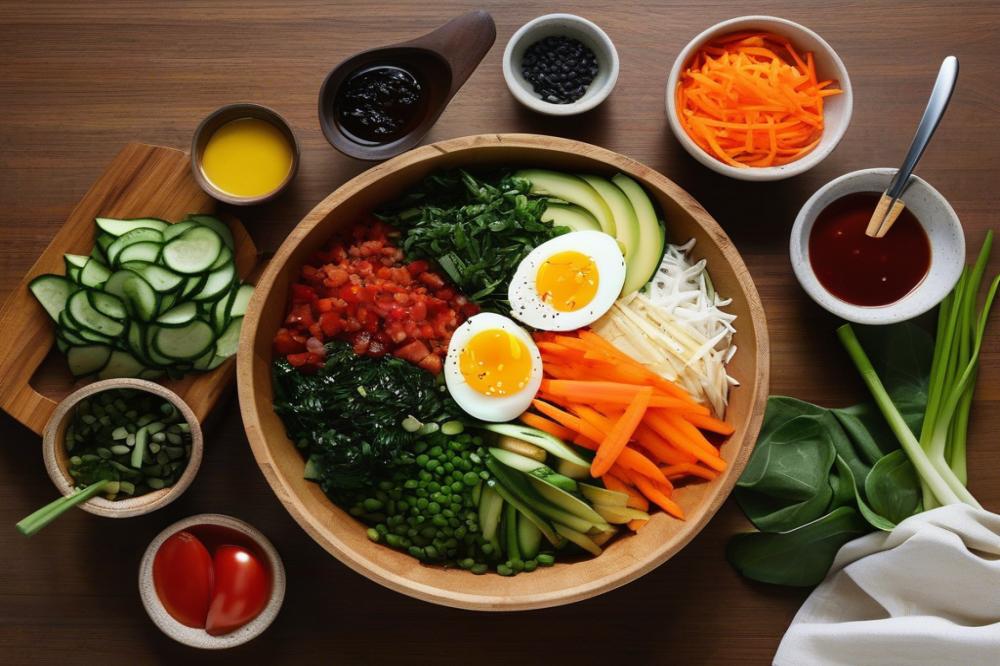
Definition and meaning of Bibimbap
Bibimbap is a popular dish in Korean cuisine. It combines rice, vegetables, and other ingredients in a harmonious way. Typically, diners mix these components together before eating. The name itself means “mixed rice.” It represents how the flavors blend and create a delightful meal.
Historical background and cultural significance
This dish has origins that date back centuries. Farmers would create it as a way to use leftover vegetables. Over time, it evolved into a staple food in Korea, often served during celebrations and gatherings. The colorful arrangement of ingredients reflects the importance of balance in food and life. As a result, it serves as a symbol of nourishment and community.
Variations of Bibimbap across Korea and globally
Regional variations of this dish are abundant in Korea. Some areas might use beef, while others prefer tofu. Vegetables can range from spinach to mushrooms, depending on local availability. Gochujang, a savory red pepper paste, is often used for added flavor. Globally, chefs have adapted the recipe in various ways. In different countries, you might find it served with unusual toppings, such as avocado or spicy chicken. Each version maintains the essence of the classic dish while showcasing unique twists.
Ingredients List and Cooking Instructions
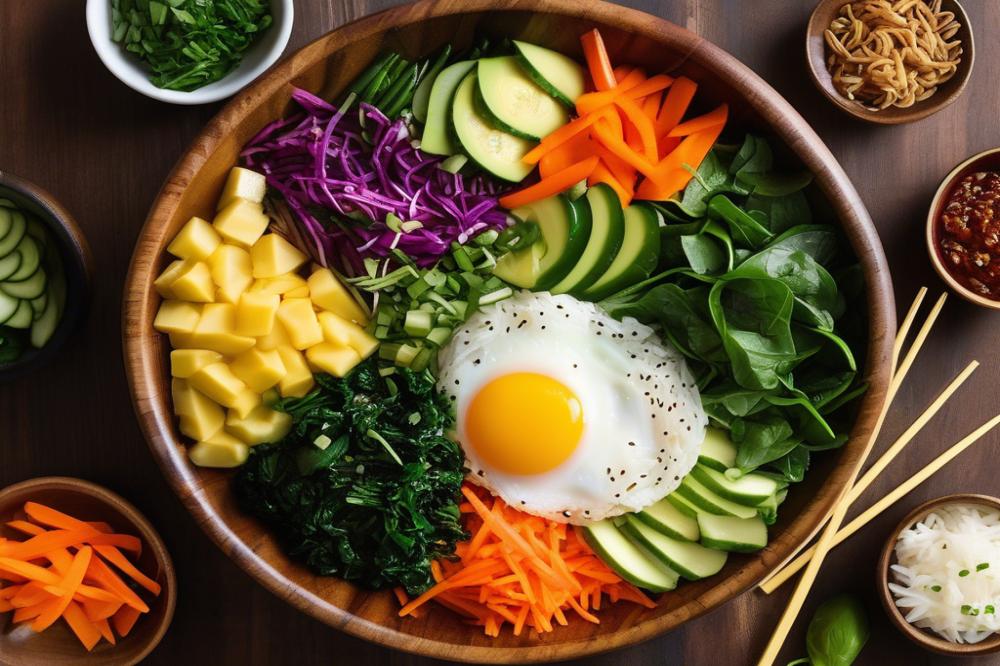
Getting started with your Korean cuisine adventure is easy. First, gather your ingredients. For this healthy meal, you will need:
- 2 cups of short-grain rice
- 1 cup of assorted vegetables, such as spinach, zucchini, carrots, and mushrooms
- 200g of ground beef or tofu for a vegetarian option
- 1 egg
- 2 tablespoons of gochujang, a spicy Korean sauce
- 1 tablespoon of sesame oil
- Salt and pepper to taste
Cooking Instructions
Start by preparing the rice. Rinse the short-grain rice under cold water to remove excess starch. This step helps achieve a fluffy texture. Cook this rice using a rice cooker or on the stovetop, following the instructions for perfect doneness.
Next, turn your attention to the vegetables. Slice them into thin strips or bite-sized pieces. Heat a pan over medium heat and add the sesame oil. Once hot, stir-fry the vegetables until they are tender yet crisp. This process enhances their flavors and colors.
Now, it’s time to cook the protein. If you are using beef, season it with salt and pepper. Sauté it in the same pan until browned and fully cooked. For the tofu option, cube it and stir-fry until it is golden on all sides. Both options add substantial taste to your dish.
While the vegetables and protein are cooking, prepare the egg. Heat a small amount of oil in another pan for frying. Crack the egg and cook it sunny-side up or over easy, depending on your preference. The runny yolk adds a rich creaminess when mixed in.
Assembling your dish is the next step. Grab a bowl and place a scoop of rice at the bottom. Arrange your sautéed vegetables and cooked beef or tofu elegantly on top of the rice. Finish with the fried egg as the centerpiece. Drizzle the dish with gochujang, adding a spicy kick. This balance of flavors brings out the essence of bibimbap.
Nutritional Information
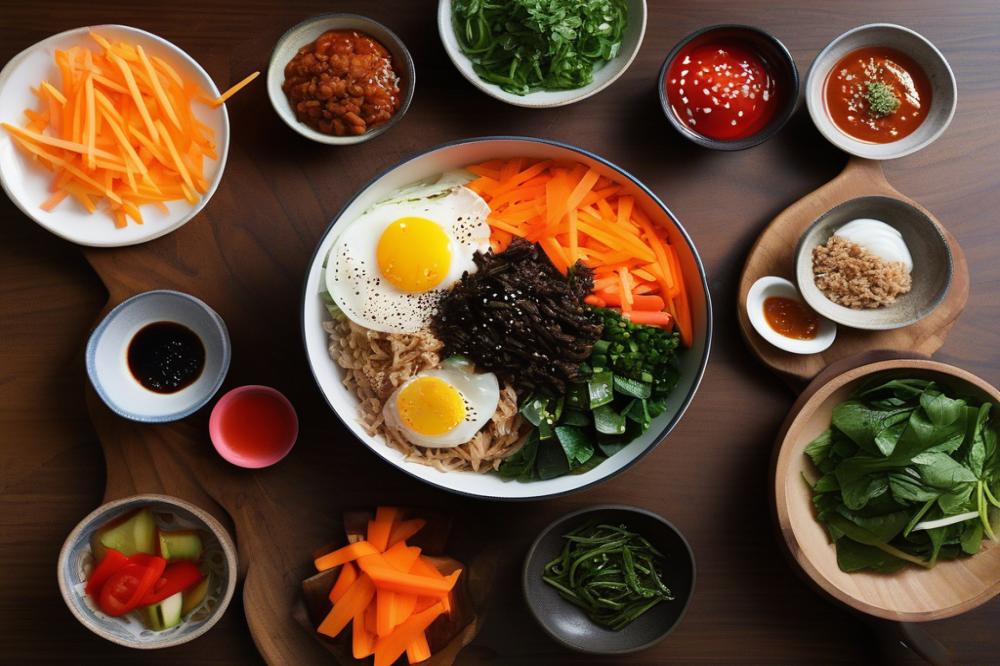
Understanding the nutritional benefits of the ingredients in a typical Korean dish can be fascinating. This meal brings together an array of colorful vegetables, which are packed with vitamins and minerals. Leafy greens like spinach and lettuce provide iron and calcium. Other vegetables like carrots and zucchini add fiber, essential for good digestion.
Rice serves as the base of this dish. It is a source of carbohydrates, providing energy for your daily activities. Each serving typically contains about 300 calories, depending on the amount of rice and other ingredients used. For protein lovers, beef or tofu can be added, which not only enhances flavor but also increases protein content.
Benefits extend beyond just vitamins and proteins. Gochujang, a fermented chili paste, contains beneficial compounds that may boost metabolism. When paired with sesame oil, it adds healthy fats that support heart health. An egg on top is a traditional choice, adding further protein and essential nutrients.
This meal is a great example of a balanced plate. Vegetables, protein, and carbohydrates blend harmoniously. Each component contributes to a healthy meal, making consumption feel more satisfying. Ultimately, it caters to various dietary preferences, whether one chooses to go with meat or opt for tofu.
With stir-fried vegetables and colorful toppings, this dish celebrates the heart of Korean cuisine. Nutritional balance is key, and this meal checks all the right boxes. Enjoying it means nourishing your body while savoring unique flavors and textures.
Tips for Making the Perfect Bibimbap
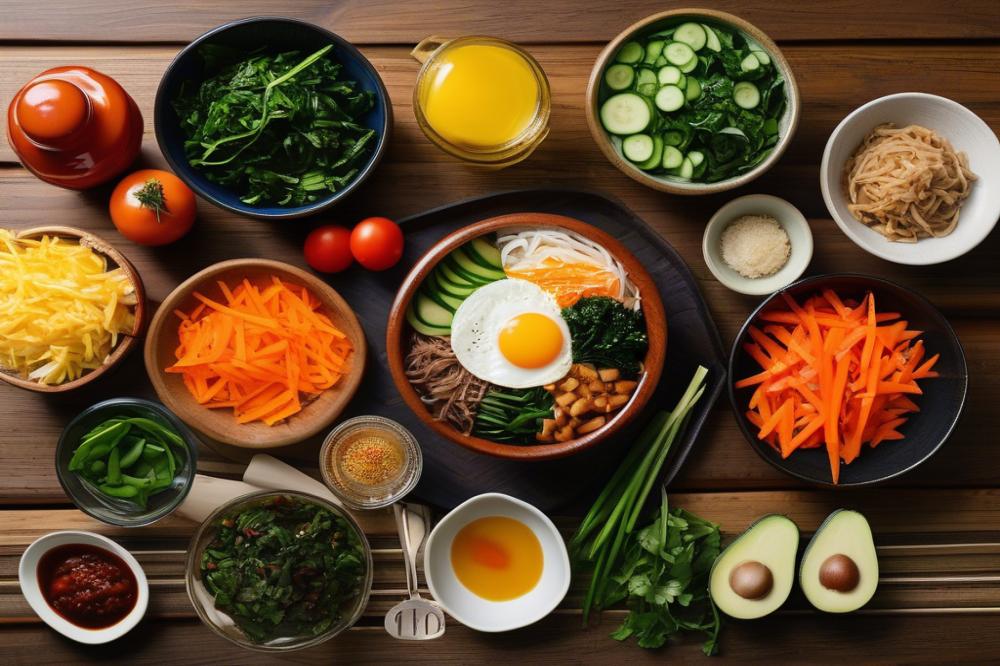
Selecting the Best Ingredients for Freshness and Flavor
Fresh ingredients are crucial for great taste. Look for colorful vegetables like carrots, spinach, and zucchini. Buy mushrooms that are firm and not slimy. When picking proteins, consider high-quality beef or tofu. Organic products often have more flavor. Gochujang adds heat and sweetness, so select a good quality brand. Also, sesame oil brings nuttiness, making all the ingredients shine.
Techniques for Cooking Rice to Achieve the Right Texture
Rice is the heart of this dish. Begin with short-grain rice for a stickier texture. Rinse it under cold water until the water runs clear to remove excess starch. After that, soak the rice for about 30 minutes before cooking. Use a rice cooker or pot with precise water measurements. For a perfect texture, allow it to rest after cooking. This step helps to firm up the rice so it holds its shape.
Suggestions for Customizing Flavors Using Various Vegetables and Proteins
Feel free to get creative with vegetables. You can add bean sprouts or cucumber for crunch. If you’re in the mood, stir-frying vegetables in sesame oil adds depth. For proteins, switching between beef and tofu can give different flavors. Marinating beef in soy sauce and garlic offers a savory punch. Don’t forget to experiment with toppings like avocado or fried shallots; these can elevate your dish.
Importance of Presentation and Garnishing
How the dish looks makes a big impact. Arrange the colorful vegetables artfully on top of the rice. A perfectly cooked egg should be placed in the center, either sunny-side up or poached. Using a sprinkle of sesame seeds can add a nice touch. Drizzling a little gochujang around can enhance the visual appeal. Aim for a dish that looks as good as it tastes, showing off the vibrant colors of Korean cuisine.
Serving Suggestions and Pairings
Kimchi serves as an ideal accompaniment. This fermented cabbage dish adds a zing to every bite. It is often made with spicy seasonings, enhancing flavors in Korean cuisine. You can choose from different varieties such as napa cabbage or radish. Their tangy taste complements the hearty main dish well.
Alongside kimchi, consider offering a selection of side dishes known as banchan. These small plates often feature items like pickled vegetables and seasoned bean sprouts. They balance the warmth of rice and vegetables, creating a wholesome experience. Adding a few savory bites keeps the meal dynamic.
For those looking to quench their thirst, pair bibimbap with traditional Korean beverages. Soju, a distilled spirit, is popular at many tables. The alcohol enhances the flavors of rice, beef, or tofu. If you prefer a non-alcoholic option, try sikhye, a sweet rice drink. It can be refreshing and light, helping to cleanse your palate.
Focusing on presentation can elevate your dining experience. Serve the dish in a hot stone bowl, if available. This keeps the rice crispy and adds an enjoyable texture. When serving, allow each person to add gochujang and sesame oil to taste. Mixing it themselves can make the meal feel personal and interactive.
Traditionally, a fried egg is placed atop the prepared dish. The yolk, when punctured, creates a creamy sauce that brings everything together. Stir-frying the vegetables separately helps retain their individual flavors. You can choose seasonal vegetables, ensuring a fresh and healthy meal.
In short, various elements come together to make your dining experience fulfilling. Simple choices transform the table into a celebration of flavors. The mix of colors and textures adds visual appeal, making each meal an event. Families often gather around to share this experience, connecting through food.
Wrapping Up: The Importance of Bibimbap
Bibimbap holds a cherished place in Korean cuisine. This dish is more than just a meal; it represents harmony, balance, and the spirit of sharing. Diners often find joy in mixing together colorful, carefully prepared ingredients. Each bowl comes alive with vibrant vegetables and savory elements. The array of textures and flavors creates a culinary experience that is hard to forget.
Trying to make this dish at home can be a rewarding challenge. The process of assembling each component will draw you into the heart of Korean culture. Explore different ingredients and step outside of your comfort zone. Cooking at home allows you to tweak recipes based on your preferences. You may discover new favorites along the way.
This classic creation excels in versatility. It can be adapted to suit various diets and taste preferences. One can add protein or keep it plant-based, depending on what feels right. Furthermore, the health benefits are abundant. Fresh vegetables provide essential nutrients while rice offers a satisfying base. Enjoy this dish as a delicious way to nourish your body and experience a beloved facet of Korean tradition.

